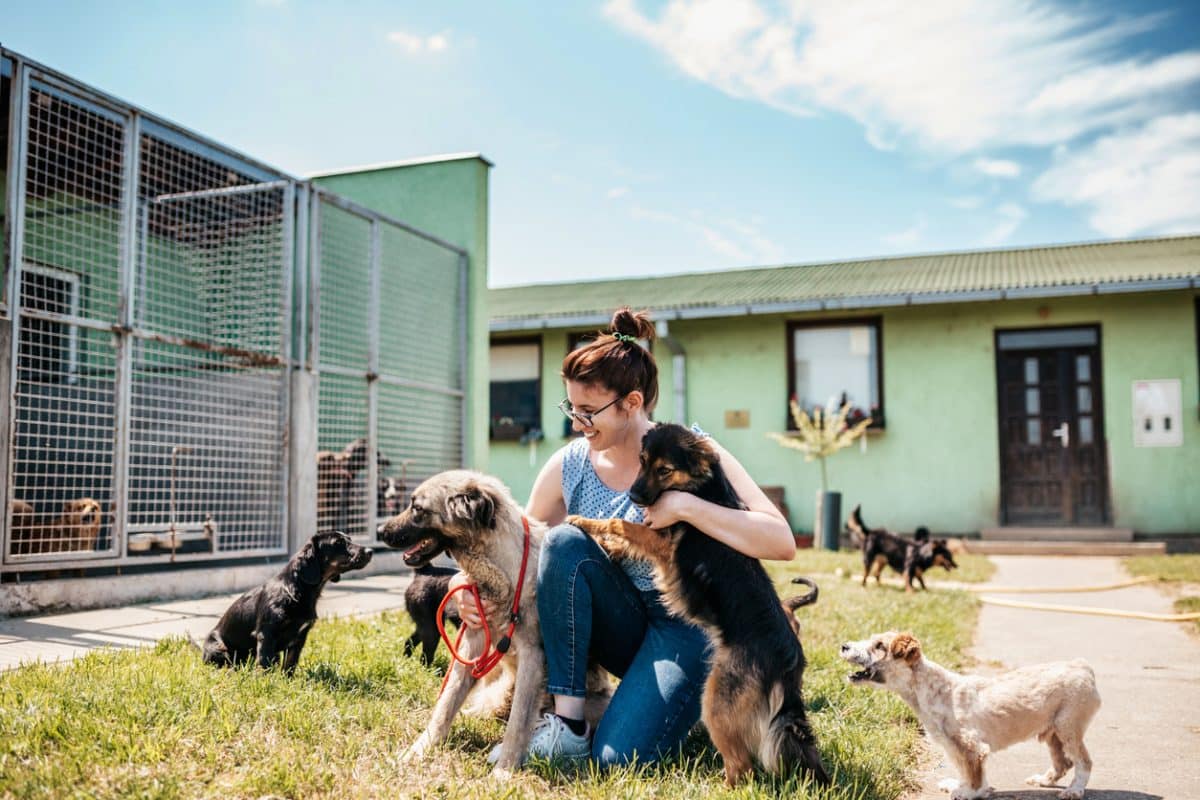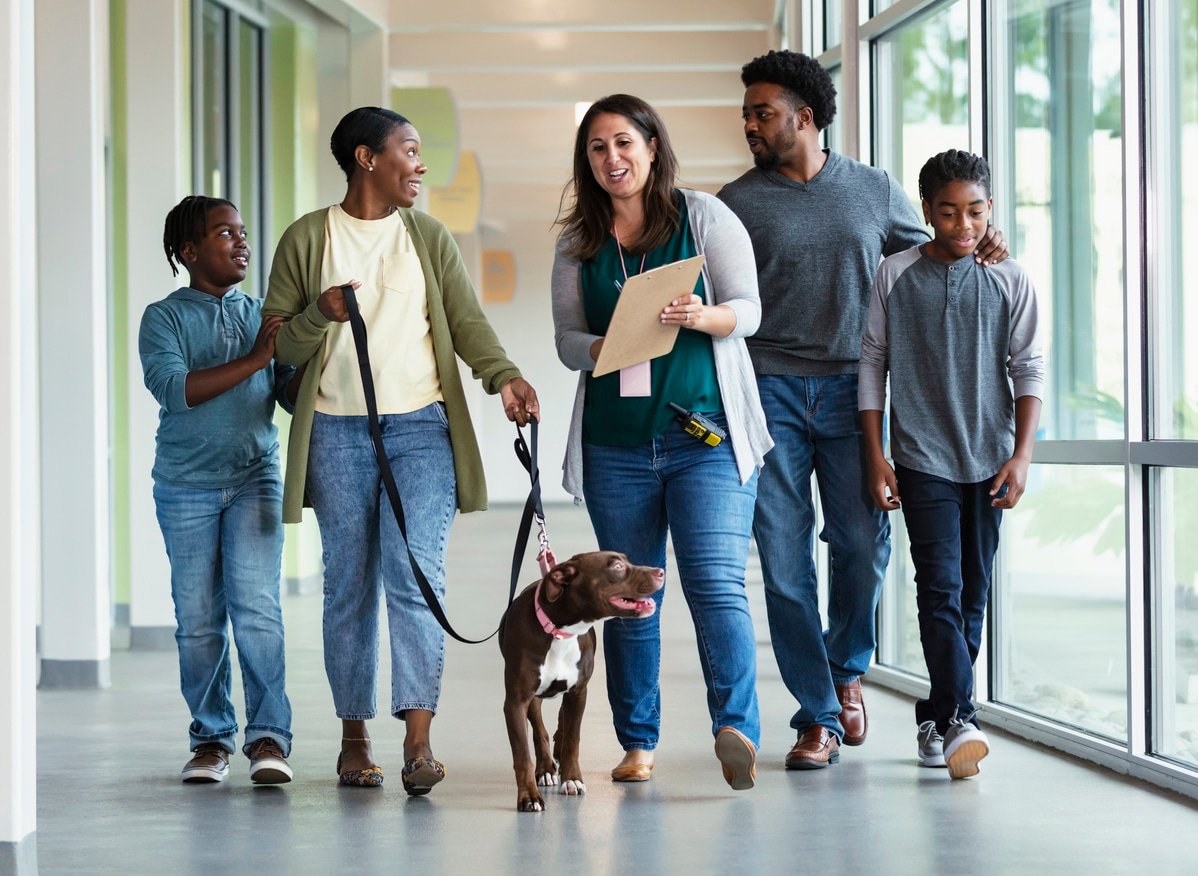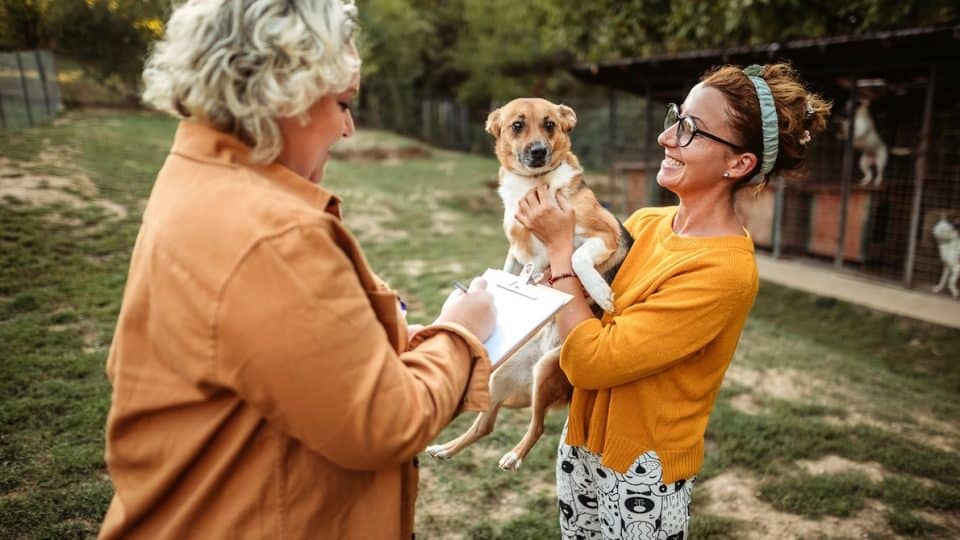Adopting a dog should be exciting. But many hopeful pet parents find the process filled with roadblocks. Lengthy applications, interviews, and strict criteria can leave prospective adopters frustrated and confused. With nearly 3 million pups entering shelters across the U.S. last year, why is it so hard to adopt a dog?
According to Laurie Hood, founder of Alaqua Animal Refuge, a no-kill shelter in Freeport, Florida, these “barriers” to adopting a dog are actually steps shelters take to ensure pups go to the right forever home. “Shelters and rescues face pressure to balance two goals: placing animals in homes quickly while ensuring those homes are safe and permanent,” she explains.
In this article, we’ll outline different avenues for dog adoption. We’ll highlight the typical requirements and challenges of each approach. We’ll also discuss the reasons behind strict adoption policies and share practical tips to boost your chances of approval.

iStock/mladenbalinovac
Are Certain Groups Stricter than Others?
The road to dog adoption differs from one organization to the next. Some are more lenient, while others have stricter requirements and vetting procedures. Understanding your options can help you find the right path to pet parenthood.
City and state-run shelters
Typically, shelters funded by local governments are the fastest and easiest route. Most shelters have an “open admission” policy where they take in any dog, regardless of breed, health, or age. This means they’re eager to clear space for incoming animals.
“Municipal shelters often have more relaxed adoption policies because they are dealing with a high volume of animals and face euthanasia pressures,” says Hood. Shelters often offer same-day adoptions, which means you can walk in, find your dog, and take them home on the same day.
Private non-profit rescues
Typically, private rescues rely on a network of fosters to house animals until the right adopter comes along. These organizations are usually run by volunteers and depend on donations for financial support.
Unlike government-run shelters, rescues are more selective with the dogs they take and strive to find them the perfect match. As such, they also tend to have stricter criteria for adoption. “Some rescues require fenced yards, home visits, or previous pet experience, which can make it feel like a daunting process,” Hood acknowledges.
Along with an extensive application, non-profit rescues often require an interview, personal and veterinary references, and even background checks for dog adopters. As challenging as these policies may seem, Hood points out they’re intended to protect animals and place them in the most compatible homes.
Breed-specific rescues
These organizations focus on specific breeds, like Siberian Huskies or Dachshunds. Many dogs in these rescues are surrendered by families who can’t meet the breed’s unique needs. As a result, breed-specific organizations have stricter policies. The goal is to ensure adopters are well-prepared to provide the necessary care for their chosen breed.
The application process can be pretty competitive, as popular breeds will be in high demand, and many rescues have limited resources. While the wait may be longer, knowledgeable volunteers can offer support on breed-related topics, like grooming or training challenging behaviors.
Local Humane Society or SPCA
The Society for the Prevention of Cruelty to Animals (SPCA) is a non-profit organization that takes in strays and owner surrenders. Each local SPCA operates independently and has its own policies. Local humane societies are also non-profit organizations. Many provide care for displaced animals and have shelters where people can adopt.
Generally, these groups have more flexible adoption policies than foster-based rescues. Adoption fees for dogs can be more expensive than a local shelter, but these organizations also tend to have a better staff-to-animal ratio. This helps them evaluate each dog more thoroughly and match them better.
| Municipal Shelter | Private Rescue | Breed-Specific Rescue | Humane Society/SPCA | |
| Adoption process | Walk-in or online application, same-day possible | Online application, interview, and home visit required, foster-to-adopt options | Detailed application, breed experience may be required | Online or in-person application, interview |
| Difficulty | Low to minimal difficulty with screening, quick approval | Moderately difficult interview, home check, references | High to strict screening, home visits, possible waitlist | Moderately difficult screening and possible interview |
| Involvement | Limited and quick process, little follow-up | Moderate post-adoption support, potential check-ins | High involvement—may require training, breed education, updates | Moderate education required and resources provided |
| Timeframe | Immediate to a few days | 1-3 weeks | 2-6 weeks (or longer) | 1-4 weeks |
| Included Services | Vaccines, spay/neuter, microchip (usually) | Vaccines, spay/neuter, microchip, some training support | Vaccines, spay/neuter, breed-specific guidance | Vaccines, spay/neuter, basic medical care |
| Types of Dogs Available | All ages, breeds, backgrounds | Mixed breeds, some purebreds, often rescued from shelters | Purebred dogs of a specific breed | Variety of breeds, ages, and backgrounds |
| Trade-offs | Fast adoption, but limited screening and support | More personalized process but slower adoption | Strict requirements and breed knowledge necessary | More structure and support, but can take longer |
Factors that Make Dog Adoption Challenging
If you’re having trouble adopting, understanding the challenges at dog adoption agencies can help. Here’s a look at the key factors at play when finding the right dog to adopt.
High volume of applicants
Many shelters and rescue groups face a flood of applicants, which creates competition for available dogs. If you have your eyes set on a particular dog, you can bet others do too. And sometimes, the rescue might consider another applicant a better fit.
Limited availability of volunteers
Most rescues operate with a small team of dedicated volunteers who also juggle full-time jobs. With only a handful of people responding to inquiries, checking references, and making phone calls, applications can take longer to review. This may lead to slow response times (and, in some cases, no response at all).
Geographical factors
Your location could also create challenges for dog adoption. In populated urban areas, higher competition can lead to more selective screening processes. There may also be extra requirements for potential adopters. In contrast, adopting may be easier in rural areas where the demand for pets is lower.
Differing views on pet care
Occasionally, an individual’s approach to pet care or training can create barriers to adopting a dog. For instance, if a rescue promotes positive reinforcement training and an applicant is not open to this method, it may result in a denied application. Similarly, a rescue might reject applicants who express they’re unwilling or unable to invest in professional training.
Compatibility concerns
Many pets are returned due to mismatched expectations or impulsive choices. Because of this, Hood says rescues are becoming more thorough in their screening processes. They want to ensure a good fit from the beginning for both the adoptive family and the dog.
Preventing further trauma
Many rescue dogs have faced abuse, neglect, and stressful environments. Carefully evaluating adopters can ensure a good fit from the beginning. By creating a lasting match, organizations reduce further distress caused by rehoming.

iStock/kali9
How To Increase Your Chances for Approval
If you’re struggling with the adoption process, don’t lose hope—there are ways to make your application stand out.
Familiarize yourself with the adoption process
First, it helps to understand the specific requirements of the group you’re interested in adopting from. Look for details on the organization’s website, talk to friends who’ve gone through the process, or reach out to staff and volunteers for guidance.
Take the time to study this criteria and prepare accordingly—whether that involves rounding up references, coming up with a care plan, or putting in a call to your vet. You’ll feel much more confident with this information in hand. Plus, it prevents surprises down the line and helps you rule out groups with standards you can’t meet (e.g., requiring a fenced-in yard).
Visit in-person
Whenever possible, try to visit a shelter or rescue in-person. Adoption groups are very busy, and sometimes phone calls or emails go unanswered. While foster-based rescues won’t have a brick-and-mortar site to visit, they frequently host adoption events at pet stores or other establishments in the community. These events are a great way to connect with volunteers and make a positive impression.
Explore different rescue groups
Don’t be discouraged if your application is denied. “Different rescues have different policies, so if one isn’t a fit, another might be,” Hood advises. Keep your options open by applying to multiple rescues, and consider expanding your search beyond your immediate geographic area. The perfect pup might just be a little further away!
Be flexible about breed, size, and age
It’s important to manage your expectations of your future dog. “Many people come in wanting a puppy or specific breed without realizing that mixed breeds or older dogs may be a better fit,” says Hood.
Small dogs and puppies tend to go fast—but don’t overlook adult dogs or bigger dogs, who may have fewer interested applicants and can make equally wonderful pets.
Where you don’t want to compromise, says Hood, is a dog’s energy level and temperament. These traits are far more relevant when it comes to lifestyle compatibility.
Make sure your application is complete
Incomplete applications are a common reason for denial, so make sure yours is thorough. Be diligent about filling out every section, and don’t intentionally leave things blank—missing references or landlord contact info can lead to your application being overlooked.
Organize proof of responsibility
Demonstrating that you’re ready for dog ownership puts you ahead of the pack. Gather references, photos of your pet-friendly home, and a care plan for your new dog ahead of time. If you rent, Hood recommends getting written permission from your landlord before applying. You can also provide contact information for your current and past veterinarians.
Show your commitment to pet parenthood
According to Hood, the best thing you can do is demonstrate you’ve given the responsibilities of pet ownership some serious thought. “Rescues want to see that you understand the responsibility, financial commitment, and time required to care for a dog long-term,” she explains, adding that rescues are more likely to approve adopters who view pets as a lifelong commitment, not just a temporary companion.
To show your commitment, share your plans for training, veterinary care, and feeding your new companion.
Be proactive and follow up
Don’t hesitate to follow up after submitting your application. A gentle nudge can bring your application back to the top of the pile and show you’re serious about adopting. Just remember to be polite.
Rescues are often overwhelmed and may take time to get back to you. If your application is declined, ask for feedback so you can improve your chances in the future.
Consider fostering
Hood suggests fostering a dog first if you lack experience with dogs. By fostering, you can gain valuable hands-on experience, which may improve your chances of being approved for adoption down the line. It also lets you conduct a first-hand behavior assessment to see if certain breeds or dogs are a fit for you.

iStock/PeopleImages
Be Patient & Keep Trying: Your Future Dog Is Out There
It can be overwhelming, but it’s important to remember that all the time-consuming paperwork and lifestyle requirements are there for a reason. Ultimately, the adoption process helps place dogs in safe and permanent homes.
The key? Approaching pet adoption with flexibility and a willingness to learn, says Hood. While waiting for the perfect match, use this time to boost your credibility as a dog parent. Familiarize yourself with common behavior challenges like reactivity or separation anxiety. Brush up on strategies for crate training, socialization, and puppy-proofing your home. Watching your friends’ pups or becoming a pet sitter are excellent ways to get real-life experience.
Don’t give up, and try not to take rejection personally. It may take time to get there, but your future pup is waiting for you!



